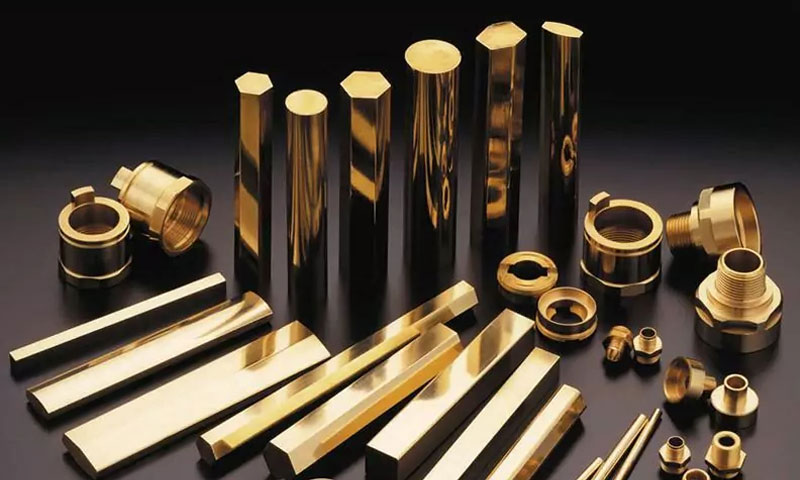Brass is a widely used metal alloy composed primarily of copper and zinc. It is renowned for its strength, resistance to corrosion, ease of machinability, and its appealing gold-like finish.
Due to its versatility, brass is used in various industries. However, different applications require different brass grades, each offering unique properties.
This ultimate guide explores various brass grades, their composition, mechanical properties, common applications, and how to select the right grade for your needs.
Understanding Brass Grades
Brass is classified based on its composition, mechanical properties, and manufacturing processes.
The percentage of zinc in brass determines its characteristics:
- Low-zinc brass (under 20% zinc): More corrosion-resistant and malleable
- Medium-zinc brass (20-35% zinc): Balanced strength and corrosion resistance
- High-zinc brass (over 35% zinc): Strong but more susceptible to dezincification
Brass grades are designated by various standards, including the UNS (Unified Numbering System), ASTM (American Society for Testing and Materials), and BS (British Standards).
Common Brass Grades and Their Properties
Alpha Brass (Single-Phase Brass)
Alpha brasses contain up to 37% zinc and are characterized by their excellent cold-working properties.
- C210 (Gilding Metal)
- Composition: 95% Cu, 5% Zn
- Properties: High ductility, excellent corrosion resistance, and good electrical conductivity
- Applications: Ammunition casings, jewelry, decorative items
- C230 (Red Brass)
- Composition: 85% Cu, 15% Zn
- Properties: High corrosion resistance, excellent formability, and antimicrobial properties
- Applications: Plumbing pipes, fittings, marine components, electrical connectors
- C260 (Cartridge Brass)
- Composition: 70% Cu, 30% Zn
- Properties: Good strength, corrosion resistance, and ductility
- Applications: Ammunition casings, radiator cores, decorative applications
- C268 (Yellow Brass)
- Composition: 65% Cu, 35% Zn
- Properties: High strength, good corrosion resistance, easy machinability
- Applications: Automotive components, jewelry, hardware
Alpha-Beta Brass (Duplex Brass)
These brasses contain 37-45% zinc and exhibit both cold-working and hot-working properties.
- C280 (Muntz Metal)
- Composition: 60% Cu, 40% Zn
- Properties: High strength, good corrosion resistance, moderate machinability
- Applications: Marine applications, architectural hardware, condenser tubes
- C330 (Low-Lead Brass)
- Composition: 65% Cu, 35% Zn, low lead content
- Properties: Improved machinability, corrosion resistance
- Applications: Plumbing, drinking water systems
- C377 (Forging Brass)
- Composition: 58% Cu, 39% Zn, 3% Pb
- Properties: Excellent hot working and forging ability, high machinability
- Applications: Plumbing fixtures, valve bodies, gas fittings
Beta Brass
Beta brasses have high zinc content (over 45%) and are suitable for casting and forging.
- C385 (Architectural Bronze/Lead-Free Brass)
- Composition: 57% Cu, 40% Zn, 3% Pb
- Properties: High strength, excellent machinability
- Applications: Architectural fittings, screws, locks
- C464 (Naval Brass)
- Composition: 60% Cu, 39% Zn, 1% Sn
- Properties: Superior corrosion resistance in seawater, high strength
- Applications: Marine hardware, propellers, pumps
Mechanical and Physical Properties of Brass
The properties of brass vary depending on composition and processing. Here are the key characteristics:
| Brass Grade | Tensile Strength (MPa) | Yield Strength (MPa) | Hardness (HB) | Elongation (%) | Electrical Conductivity (% IACS) |
|---|---|---|---|---|---|
| C210 | 250-400 | 70-150 | 55-75 | 40-50 | 43-50 |
| C230 | 250-500 | 75-170 | 55-80 | 30-45 | 35-45 |
| C260 | 300-550 | 95-250 | 60-85 | 25-40 | 27-35 |
| C280 | 300-600 | 100-250 | 70-90 | 20-35 | 24-32 |
| C377 | 400-700 | 140-300 | 80-100 | 10-25 | 23-30 |
| C464 | 350-650 | 120-250 | 75-95 | 15-35 | 23-30 |
Applications of Different Grade Brass

Brass is used across many industries due to its corrosion resistance, machinability, and antimicrobial properties.
Manufacturing and Engineering
- C260 (Cartridge Brass): Ammunition casings, automotive radiators
- C377 (Forging Brass): Valves, gas fittings, plumbing parts
- C385 (Architectural Bronze): Screws, locks, hinges
Marine and Plumbing
- C230 (Red Brass): Pipes, plumbing fittings
- C464 (Naval Brass): Marine hardware, propellers
Electrical and Electronics
- C260 (Cartridge Brass): Electrical connectors
- C280 (Muntz Metal): Heat exchangers
Decorative and Musical Instruments
- C210 (Gilding Metal): Jewelry, decorative items
- C268 (Yellow Brass): Musical instruments, trophies
Choosing the Right Brass Grade
When selecting brass for an application, consider the following factors:
Corrosion Resistance
- For marine applications, use C464 Naval Brass (contains tin for seawater resistance).
- For plumbing, use C230 Red Brass (high corrosion resistance).
Machinability
- For high machinability, use C377 Forging Brass (contains lead).
- If lead-free is required, C385 Lead-Free Brass is a great alternative.
Strength and Durability
- C260 Cartridge Brass provides a balance of strength and flexibility.
- C280 Muntz Metal is ideal for structural applications.
Aesthetic Appeal
- C210 Gilding Metal offers a rich golden color.
- C268 Yellow Brass is popular for musical instruments and decorative uses.
Brass Alloy Comparison with Other Metals
Brass is often compared with other metals like copper, bronze, and stainless steel. Here’s how it stands out:
| Property | Brass | Copper | Bronze | Stainless Steel |
|---|---|---|---|---|
| Corrosion Resistance | Moderate to high (C464 best) | High | High | Very High |
| Strength | Medium to High | Medium | High | Very High |
| Machinability | Excellent (C377, C385) | Poor | Moderate | Poor to Moderate |
| Electrical Conductivity | Moderate (C210 highest) | Very High | Low to Moderate | Low |
| Cost | Moderate | High | Moderate to High | High |

